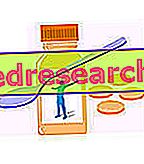Generality
Hydrogen peroxide, or hydrogen peroxide, is a chemical compound that acts as a disinfectant, oxidant and bleaching agent.

Hydrogen peroxide is used in various fields, including the medical field, the cosmetic field and the industrial field.
In the medical field, hydrogen peroxide is a moderate disinfectant, particularly useful for:
- to prevent skin infections in small wounds;
- mitigate irritation in the mouth;
- sterilize surgical instruments and operating rooms.
As a disinfectant, hydrogen peroxide causes rare adverse effects, is usable during pregnancy and lactation, is inexpensive and is widely available on the market.
What is oxygenated water
Hydrogen peroxide, or hydrogen peroxide, is a liquid chemical compound, of formula H 2 O 2 and acting as a disinfectant, oxidant and bleaching agent .
STRUCTURE
It is a widespread tendency to describe hydrogen peroxide as "water with an extra oxygen atom" (NB: the chemical formula of water is H 2 O).
Indeed, hydrogen peroxide comprises two oxygen atoms, joined together by a single chemical bond, and two hydrogen atoms, each linked to an oxygen atom.
However, the aforementioned description ("hydrogen peroxide is water with an extra oxygen atom") is not appropriate, as it could lead someone to think that the differences between the two compounds are not so deep.
In reality, that extra oxygen atom gives hydrogen peroxide extremely different properties and characteristics from water.
Hydrogen peroxide is the simplest of peroxides. In chemistry, the term peroxide identifies a compound containing two oxygen atoms joined together by a single covalent bond.
SOME FEATURES AND PROPERTY
In pure form, hydrogen peroxide is a colorless, corrosive liquid with a pungent odor, whose boiling temperature is 150.2 ° C (approximately 50 ° C more than water).

With its dilution, hydrogen peroxide changes some of its properties and becomes a safer chemical compound. For example, the normally marketed product has a boiling temperature of 114 ° C, which reduces the risk of its explosive reaction.
DISCOVERY AND SOME HISTORICAL NEWS
A first description of hydrogen peroxide belongs to a French chemist named Louis Jacques Thénard and dates back to 1818. Thénard obtained hydrogen peroxide by reacting barium peroxide with nitric acid.
To synthesize for the first time hydrogen peroxide in pure form was a German chemist named Richard Wolffenstein, almost 80 years after Thénard's description, precisely in 1894.
The identification of the precise molecular structure of hydrogen peroxide required years of research.
The British physicist and mathematician William Penney and the Scottish physicist Gordon Sutherland made a fundamental contribution to these studies on the molecular structure.
uses
Hydrogen peroxide is mainly used in the industrial sector, in the medical field and in the cosmetic sector.
Here and in subsequent chapters, its use in the medical field is of particular interest.
MEDICAL USE
In the medical field, hydrogen peroxide is a moderate potency disinfectant, effective against bacteria, bacterial spores, viruses and yeasts.
These disinfectant properties make it useful for:
- Prevention of infections that can result from small cuts, grazes and minor skin burns . To obtain the desired preventive effects from the hydrogen peroxide, the user must clean up the anatomical area of interest and apply the disinfectant product in question more than once a day.
Furthermore, doctors advise, after each application, to bandage the wound in such a way as to reduce the risk of microbial contamination.
Regarding the use warnings, contact with the eyes and application on very large wounds should be avoided.
In case of poor results, the user should consult the attending physician.
- Mouth cleansing and reduction of oral irritation . In general, doctors advise the use of hydrogen peroxide, for mouth washing, for patients with gingivitis, cold sores and minor oral injuries.
In these situations, the methods of use are very simple: the user must mix a certain amount of hydrogen peroxide in a glass with an equal amount of water, pour it into his mouth, without swallowing it, and keep it in place for at least one minute.
For best results, the user should repeat the above operation at least 4 times a day.
If, despite the use of hydrogen peroxide, oral problems persist, the user should consult the doctor in charge.
- Sterilization of surgical instruments and operating rooms .
Benefits of hydrogen peroxide as a disinfectant
Hydrogen peroxide is an advantageous disinfectant for at least two reasons: easy availability on the market (the product for skin use can also be purchased in a normal supermarket) and the low cost.
COSMETIC USE
In the cosmetic field, hydrogen peroxide is known for at least three reasons:
- As a hair bleaching agent . In this case, it must be mixed with ammonium hydroxide. The effect on the hair is also known as oxygenated blond.
- As a teeth whitening agent . In these situations, the user can mix it with baking soda and salt (sodium chloride) to make a homemade toothpaste.
- As an anti-acne product .
INDUSTRIAL USE
In the industrial environment, hydrogen peroxide can be used in various sectors:
- In the paper industry, it represents a product for bleaching cellulose and paper.
- In the textile industry, it represents a product for bleaching clothes.
- In the water purification sector, it is an oxidizing agent that eliminates some impurities that can be found in the water.
- Etc.
OTHER USES
Hydrogen peroxide is a chemical compound also used in the realization of:
- Propellants
- Explosives
- Fluorescent sticks (or glow sticks )
In addition, it is also used in horticulture - as an improvement on root development of plants - and in the breeding of small fish, for which it represents a source of oxygen.

Adverse effects
If used as a disinfectant for skin wounds, hydrogen peroxide could, in some rare situations, cause redness, pungent pain and / or irritation, all at the site where it is applied.
If these adverse effects persist, it is advisable to contact the doctor for a consultation.
ARE ALLERGIC REACTIONS POSSIBLE?
Rarely, the use of hydrogen peroxide causes allergic type reactions.
Characterized by skin rash (exanthema), itching, swelling of the face / tongue / throat, dizziness and / or breathing difficulties, allergic reactions from hydrogen peroxide require immediate medical advice.
Precautions
Premise: the hydrogen peroxide used as a disinfectant for wounds and for oral cleaning contains excipients that are harmless to most people.
Before disinfecting with hydrogen peroxide, the user should make sure that the product does not contain excipients to which he is allergic.
The doctors, in fact, strongly advise against the use of hydrogen peroxide preparations capable of developing an allergic reaction.
USE IN PREGNANCY AND DURING BREASTFEEDING
The use of hydrogen peroxide in pregnancy is safe and does not present any contraindications.
Regarding the use of hydrogen peroxide during lactation, some scientific evidence shows that the product rarely goes to breast milk.
Therefore, in this second case, it is always better to ask your doctor for advice.
Interactions
Hydrogen peroxide does not present particular interactions with other drugs.
However, to act in maximum safety, it is always better to seek advice from your trusted pharmacist or your doctor (especially if you are an individual who, for particular health reasons, regularly takes one or more medicines).
Overdose and more
Cases of overdose due to hydrogen peroxide are very rare.
If swallowed, it is advisable to contact your doctor immediately, because, in these situations, hydrogen peroxide could be harmful.
IN CASE OF FAILURE TO TAKE
To the user who forgets an application of hydrogen peroxide, the doctor recommends using the product as soon as he becomes aware of forgetfulness and as soon as he has the chance.
The recovery of forgotten administration requires the postponement of subsequent doses.
Forgetting an application is not a good reason to double the doses of hydrogen peroxide.
Curiosity
The following list shows a series of curious uses of hydrogen peroxide in various areas, from those related to health and beauty to the domestic one.
- For nail whitening. To whiten the nails of hands and feet, it is necessary to immerse the latter in a solution based on hydrogen peroxide for a few minutes.
- To soften corns and calluses. The softening effect with regard to calluses and calluses is obtained by mixing the hydrogen peroxide with hot water and immersing the anatomical part of interest (usually feet or hands) in the resulting solution.
- For earwax cleaning. The application in a ear of a few drops of hydrogen peroxide for 1-2 minutes, followed by the application of a few drops of olive oil for an equal time, favors the elimination of the cerumen, when the drainage of as applied.
- To prevent sweaty ear infections. In these situations, the application of hydrogen peroxide must take place shortly after bathing in water.
- To prevent ear infections. A few drops of hydrogen peroxide in the ear clean the ear of dangerous bacteria that could infect it.
- For cleaning kitchen surfaces. Hydrogen peroxide effectively removes dirt and stains from the surfaces of the home kitchen, an environment where hygiene is essential.
- For cleaning the surfaces of the bathtub.
- For mirror cleaning.
- To prevent the growth of mold and fungus on the surfaces of the home most at risk.
- For cleaning fruits and vegetables. After washing fruit and vegetables in hydrogen peroxide, they must be washed in drinking water.
- For the disinfection of cutting boards and other similar objects, where usually raw meat or vegetables are placed.
- For cleaning the refrigerator at home. In this case, the application of hydrogen peroxide must last a few minutes. To remove the product, it is good to use a clean cloth.
- To eliminate odors from moldy fabrics. To obtain the desired results, the moldy tissues must be immersed in a solution based on hydrogen peroxide and white vinegar.



